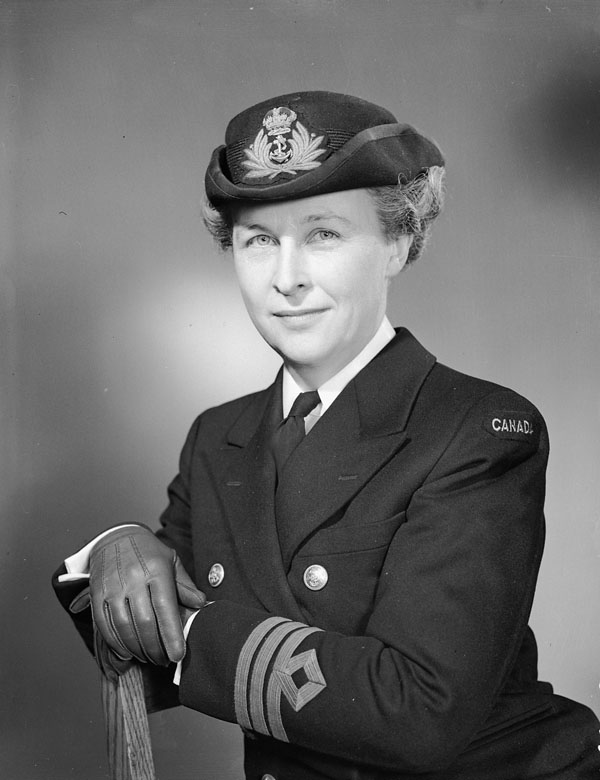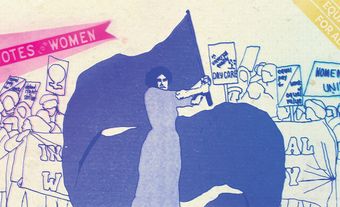Adelaide Sinclair, OC, OBE, naval officer and public servant (born 16 January 1900 in Toronto, ON; died 19 November 1982 in Ottawa, ON). Adelaide Sinclair was the first Canadian director of the Women’s Royal Canadian Naval Service (1943–46). Following the Second World War, she became Canada’s delegate to UNICEF. She was UNICEF’s deputy executive director of programs from 1957 to 1967.

Early Life and Education
Adelaide Helen Grant Sinclair (née MacDonald) was born on 16 January 1900 in Toronto, Ontario. Her father, Overton Fullarton MacDonald, was a physician, while her mother, Adelaide Sullivan, was the daughter of barrister Robert Sullivan. Dr. MacDonald died in August 1901, several months before the birth of his second child, son Robert Overton Grant, who was born in December of that year.
Sinclair grew up in Toronto and attended Havergal College, a private girls’ school, graduating in 1917. Upon her family’s insistence, she then took a six-month course in domestic science. In 1918, she enrolled at the University of Toronto, where she earned a degree in political science in 1922, followed by a master’s degree in economics in 1925.
Did you know?
While attending the University of Toronto in the 1920s, Adelaide Sinclair (then Adelaide MacDonald) was captain of the women’s hockey team. (See also The History of Canadian Women in Sport.)
Marriage and Early Career
After earning her master’s degree, Adelaide Sinclair moved to Europe, where she did postgraduate work at the London School of Economics and Political Science and the University of Berlin. She returned to Canada in 1929 and lectured in political science and economics at the University of Toronto. In 1930, she married Toronto lawyer Donald Black Sinclair. Their marriage was short-lived, as her husband died in 1938.
After the Second World War (1939–45) began, Sinclair took a position at the Central Volunteer Bureau and became chairman of the Women’s Salvage Committee. In 1942, she moved to Ottawa, where she became an economist with the Wartime Prices and Trade Board.

Director of WRCNS
In 1943, Adelaide Sinclair joined the Women’s Royal Canadian Naval Service (WRCNS). The service was founded in 1942, following the example of the air force and army, which had created women’s divisions in 1941. (See RCAF Women’s Division and Canadian Women’s Army Corps.) The WRCNS was patterned after the United Kingdom’s Women’s Royal Naval Service (WRNS) and, at first, senior leadership positions were staffed by members of the WRNS on loan from the Royal Navy. The first director of the Canadian service was WRNS chief officer Dorothy Isherwood. The WRCNS began recruiting in summer 1942. The first class of 67 women began training in August, and by October the WRCNS had commissioned its first Canadian officers (see alsoIsabel Macneill). Sinclair joined the WRCNS in March 1943 and was sent to England to train with British “Wrens.” When Dorothy Isherwood returned to Britain later that year, Sinclair became director in her place.
Sinclair was appointed commander of the WRCNS on 18 September 1943. Under her leadership, the service grew significantly. By the end of the war, more than 6,700 women had joined the WRCNS; Canadian “Wrens” served in 39 trades, from administration and signalling to coding and intelligence. Sinclair was director of the WRCNS until 1946, when the service was disbanded. She was not only the first Canadian director of the service but also the first woman to earn the rank of captain in the Royal Canadian Navy.

UNICEF
Following the Second World War, Adelaide Sinclair became executive assistant to the Deputy Minister of National Health and Welfare (1946–57). In 1946, she was also appointed as the Canadian delegate to the newly created United Nations’ International Children’s Emergency Fund (UNICEF), now known as the United Nations Children’s Fund. She remained involved in the organization until her retirement in 1967. By that time, she had risen through the ranks and was “one of the highest ranking and most powerful women at the United Nations at the time.” Among other positions, Sinclair was UNICEF’s deputy executive director of programs from 1957 to 1967.
Legacy
Adelaide Sinclair was honoured for her life of public service. In 1945, she became an Officer of the Order of the British Empire (OBE) for her “untiring zeal and outstanding ability, tact and judgment in organizing the WRCNS into a most efficient and well-disciplined unit.” In 1967, Sinclair was named an Officer of the Order of Canada (OC) for her contributions to Canada as director of the WRCNS and her work with UNICEF. The following year, she received an honorary Doctor of Laws from The University of British Columbia.
Sinclair died on 19 November 1982 in Ottawa. She was buried beside her husband in Mount Pleasant Cemetery in Toronto. In 2012, a bust of Sinclair was unveiled at the Naval Museum of Halifax during the opening of an exhibit marking the 70th anniversary of the WRCNS. The bust was created by Christian Corbet, the RCN’s sculptor-in-residence.

 Share on Facebook
Share on Facebook Share on X
Share on X Share by Email
Share by Email Share on Google Classroom
Share on Google Classroom










